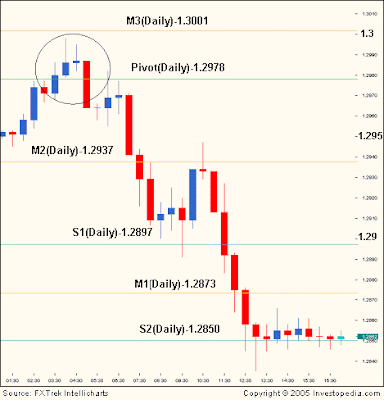The Significance of Market Opens
One of the key points to understand when trading pivot points in the FX market is that breaks tend to occur around one of the market opens. The reason for this is the immediate influx of traders entering the market at the same time. These traders go into the office, take a look at how prices traded overnight and what data was released and then adjust their portfolios accordingly. During the quieter time periods, such as between the U.S. close (4pm EDT) and the Asian open (7pm EDT) (and sometimes even throughout the Asian session, which is the quietest trading session), prices may remain confined for hours between the pivot level and either the support or resistance level. This provides the perfect environment for range-bound traders.
Two Strategies Using Pivot Points
Many strategies can be developed using the pivot level as a base, but the accuracy of using pivot lines increases when Japanese candlestick formations can also be identified. For example, if prices traded below the central pivot (P) for most of the session and then made a foray above the pivot while simultaneously creating a reversal formation (such as a shooting star, doji or hanging man), you could sell short in anticipation of the price resuming trading back below the pivot point.
A perfect example of this is shown in Figure 3, a 30-minute USD/CHF chart. USD/CHF had remained range-bound between the first support zone and the pivot level for most of the Asian trading session. When Europe joined the market, traders began taking USD/CHF higher to break above the central pivot. Bulls lost control as the second candle became a doji formation. Prices then began to reverse back below the central pivot to spend the next six hours between the central pivot and the first support zone. Traders watching for this formation could have sold USD/CHF in the candle right after the doji formation to take advantage of at least 80 pips worth of profit between the pivot point and the first level of support.
|
|
Another strategy traders can use is to look for prices to obey the pivot level, therefore validating the level as a solid support or resistance zone. In this type of strategy, you're looking to see the price break the pivot level, reverse and then trend back towards the pivot level. If the price proceeds to drive through the pivot point, this is an indication that the pivot level is not very strong and is therefore less useful as a trading signal. However, if prices hesitate around that level or "validate" it, then the pivot level is much more significant and suggests that the move lower is an actual break, which indicates that there may be a continuation move.
The 15-minute GBP/CHF chart in Figure 4 shows an example of prices "obeying" the pivot line. For the most part, prices were first confined within the mid-point and pivot level. At the European open (2am EDT), GBP/CHF rallied and broke above the pivot level. Prices then retraced back to pivot level, held it and proceeded to rally once again. The level was tested once more right before the U.S. market open (7am EDT), at which point traders should have placed a buy order for GBP/CHF since the pivot level had already proved to be a significant support level. For those traders who did do that, GBP/CHF bounced off the level and rallied once again.
Conclusion
Traders and market makers have been using pivot points for years to determine critical support and/or resistance levels. As the charts above have shown, pivots can be especially popular in the FX market since many currency pairs do tend to fluctuate between these levels. Range-bound traders will enter a buy order near identified levels of support and a sell order when the asset nears the upper resistance. Pivot points also enable trend and breakout traders to spot key levels that need to be broken for a move to qualify as a breakout. Furthermore, these technical indicators can be very useful at market opens.
Having an awareness of where these potential turning points are located is an excellent way for individual investors to become more attuned to market movements and make more educated transaction decisions. Given their ease of calculation, pivot points can also be incorporated into many trading strategies. The flexibility and relative simplicity of pivot points definitely make them a useful addition to your trading toolbox.




















